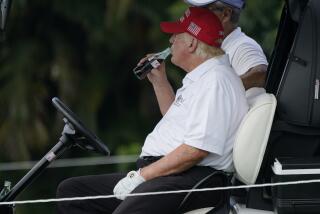Clinton Unveils Drug Plan to Divert Youthful Users
- Share via
WASHINGTON — Citing a continuing rise in drug use among youth, President Clinton proposed a 10-year drug-control plan Tuesday aimed at keeping young Americans from joining the ranks of the country’s 3.6 million adult addicts.
“While overall use of drugs in the United States has fallen dramatically--by half in 15 years--adolescent drug abuse continues to rise,” the president said. “That is why the No. 1 goal of our strategy is to motivate America’s youth to reject illegal drugs and substance abuse.”
He called on the private sector to join government by paying for half of a $350-million ad campaign to broadcast antidrug messages for young people during prime-time television hours.
The president’s 1997 “national drug control strategy,” an annual report mandated by Congress, identifies reduction of drug use by youths as its top priority. It also calls for prevention of underage drinking and smoking.
“We have to become angry whenever any child, one single child, becomes prey for drugs and violence,” Clinton told dozens of law enforcement officers, health officials and members of Congress at a White House ceremony unveiling the report.
He said that his budget for the 1998 fiscal year that starts Oct. 1 proposes $16 billion for antidrug efforts, an increase of $818 million over the previous year.
Besides the ad campaign, increased spending would go to beef up the congressionally approved Safe and Drug-Free Schools program, to hire hundreds of additional Border Patrol officers to stem the flow of drugs across the Mexican border and to help finance programs aimed at reducing cocaine production in Peru, the prime source of that drug.
Clinton said that a long-term strategy needs to be adopted that includes “educating citizens, treating addiction and seizing the initiative in dealing with criminals who traffic not only in illegal drugs but in human misery and lost lives.”
“Every year drug abuse kills 14,000 Americans and costs taxpayers $70 billion,” he said, pointing out that drug addiction fuels spouse and child abuse, violent crime, workplace and motor vehicle accidents, absenteeism in the work force and the spread of AIDS.
Retired Gen. Barry R. McCaffrey, the president’s drug policy coordinator, said in the report that about 12.8 million American adults, including 3.6 million hard-core addicts, use illegal drugs on a regular basis. This number has dropped dramatically from a 1979 high of 25 million, he said.
McCaffrey cited a study by the Santa Monica-based Rand think tank showing that chronic users account for two-thirds of the U.S. demand for cocaine. Thus, although the number of cocaine users has decreased, the amount of cocaine consumed in this country has remained about the same.
Marijuana use continues to be the major drug problem among the nation’s youth, along with alcohol, McCaffrey said.
Other members of the president’s Drug Policy Council who attended the ceremony were Vice President Al Gore, Atty. Gen. Janet Reno, Health and Human Services Secretary Donna Shalala, Transportation Secretary Rodney Slater and Gen. John M. Shalikashvili, chairman of the Joint Chiefs of Staff.
More to Read
Sign up for Essential California
The most important California stories and recommendations in your inbox every morning.
You may occasionally receive promotional content from the Los Angeles Times.













